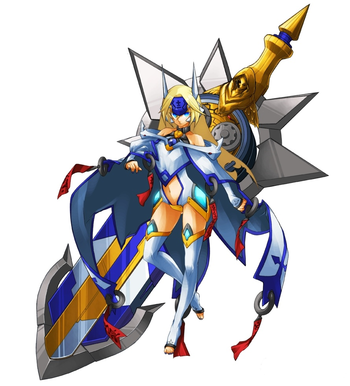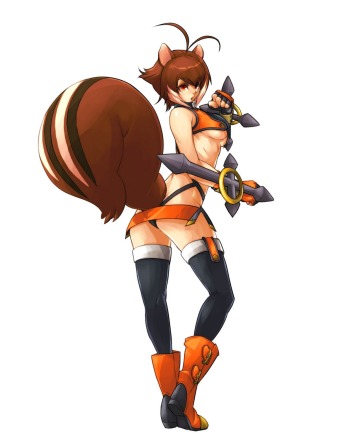
My odd fascination with fighting games continues. I constantly wrestle with a desire to play them that doesn’t mesh with my complete lack of skill in the genre and it’s no secret I don’t have the kind of dedication necessary to spend the many, many hours practicing diligently in one title that it takes to truly improve.
I’ve ultimately decided it’s a genre I like dabbling in. It’s an expensive, often frustrating dalliance, to be sure, and one that I sort of hope I can muster the willpower to give up someday and free my mind and time for better things, but until then my love/hate relationship with the genre will continue.
My first hour with BlazBlue perfectly typified this usual relationship. There was fun, excitement, and frustration. Nothing new there.
But enough about my masochistic genre tendencies, the real question is whether my $40 was well-spent on this update to the crazy 2D fighting antics the original BlazBlue established.
BlazBlue: Continuum Shift is in an awkward position commercially. It comes out only a few months after the release of the superb Super Street Fighter IV, a game that bested its predecessor in nearly every way, delivered a whopping 10 new characters, and chopped $20 off of the price for an amazing value on top of everything else.
Continuum Shift wisely follows suit with a price drop of its own, but otherwise can’t match the quantity of cool new stuff added to Super Street Fighter IV (nor could it really hope to, being an original franchise with 2D art assets as opposed to a long-established franchise with 3D art). So the package clearly doesn’t feel as substantial as one might hope. But that doesn’t mean it’s not still worth it. Is it?
Honestly, that’s a hard question to answer.
There’s no denying that my first hour with the game brought an overwhelming sense of deja-vu. I was bombarded with music, stages, modes, and characters pulled directly from the first game. Super Street Fighter IV’s massive character select screen alone was enough to justify the price tag and make the update feel substantial, but there’s no similar sense of massive improvement here. Instead, we get a number of small but welcome features, and two new characters, both welcome additions to what was already a small roster, but there’s no denying that more would have been welcome.
To be clear, technically the game features three new characters, but the third is buried as an unlockable that will take most gamers many hours of play to reach. This is utterly stupid in a game with this few new characters to begin with.

This leads into another worrying issue: DLC overload. A lot of content in the game is locked behind doors that are going to be nigh insurmountable for casual players. To unlock the Unlimited versions of each character, for instance, you have to play through the notoriously controller-smashingly difficult Score Attack mode with each one. Ludicrous. But, should the idea of that much frustration leave a bitter taste in your mouth, you can easily unlock the Unlimited versions another way… by paying 50 cents a pop for an unlock code that makes them magically appear. The included twelve color palette swaps per character not enough? Three packs of additional shiny colors are available so far at about $4 each. Want some new system voices? Three are available now at about $5 each. Don’t feel like putting in the many hours necessary trudging through the hours of static text screens that make up the story mode so you can actually play as one of the three new characters you just paid $40 for? Why, by paying just $2 more, you can have the character unlocked for you automatically, just like it should have been in the first place!
Admiteddly, a lot of the DLC is totally optional and forgettable, but the unlock codes go too far. Super Street Fighter IV shipped with everything important unlocked right from the beginning. Continuum Shift has clearly placed potentially interesting content behind hefty barriers in hopes of getting you to pay extra to unlock them instead of going through the grind. This is the worst kind of DLC abuse, plain and simple.

There’s another piece of DLC worthy of note too. A new character. Makoto, the adorable, scantily-clad squirrel girl that’s sure to get the attention of furry fans everywhere, is available for $7. I’ll have a more detailed report on this DLC addition to the cast soon.
I’m not normally one to raise the “it should have been on the disc” flag when it comes to downloadable goodies, because most of the time it’s a stale argument stemming from a lack of knowledge about how game development works. Here, however, in a game with only three new cast members, one of whom is locked away for quite some time, I’m forced to ask whether this spamming of DLC, and unlock codes in particular, is simply a ploy to make as much as possible of that missing $20 back from every player they can. I’m not saying this is the case, but we’re already dealing with a tricky value proposition and this definitely doesn’t make things any clearer.
Let us not paint a bleak picture too hastily, however. BlazBlue is a fun fighting game and Continuum Shift continues to be enjoyable. There are a few new stages, new additions to the terrific soundtrack, and, most interestingly, new modes as well.
Story mode returns, not much changed but more streamlined. It brings with it the insane, nigh-incomprehensible, yet somehow utterly fascinating storyline that the first game started. You’ll spend an ungodly amount of time reading and staring at static images, but if you’re anything like me you’ll find the proceedings interesting despite yourself. The fact that every character seems to have an immensely humorous “Gag Reel” storyline to pursue helps a great deal as well. There looks to be quite a bit of content to explore here, and with difficulty settings and the new, button-masher-friendly beginner controls both applicable to story mode, even scruffy casual players should be able to have fun screwing around in the unique world of BlazBlue. Continuum Shift is no Mass Effect, but it’s a decent effort for a fighting game and it’s definitely charming.
Also of note are the new training options, something I was particularly interested in. There are a number of tutorials that do a decent job of introducing you to the BlazBlue fighting system. Each character also has a specific strategy explanation for how best to use them, complete with notable combos and situationally useful moves, though if you haven’t played around with a character already a lot of this will go straight over your head. Finally, the Challenge mode has you repeating sets of move inputs, ranging from basic special moves to insanely complex combos. This mode bears a striking resemblance to the Super Street Fighter IV mode of the same name, but Continuum Shift’s version is far superior. It’s just as intensely difficult and full of massively intimidating combos, but it gives you tools to help you out that SSFIV is lacking, such as the ability to have the game demonstrate the combo you’re working on and clear timing indicators for when each part of a combo should be performed.
These modes are still a far cry from being useful to the truly uninitiated, but I hesitate to criticize them too much because, imperfect though they may be, Continuum Shift still has the best set of training modes and tutorials of just about any fighting game I’ve played. This isn’t the game that solves the genre’s fundamental problems with insurmountably steep learning curves, but its efforts at teaching new players are far above average and a step in the right direction.
Ultimately though, my first impressions lead me to believe that Continuum Shift is best suited for either those who are huge fans of the original or those that skipped the first outing and want to get a taste of its antics at a reduced price. Despite the training modes and beginner controls, this is a seriously hardcore, difficult fighting game and casual dabblers will quickly find that there’s not much in the game suited for them, save perhaps for story mode which isn’t something everyone will enjoy.
That said, it’s a charming game with a lot of replay value if it hooks you, and its $40 price tag makes for easy entry. If you don’t mind a bit of deja-vu in your sequel then it might just be worth giving it a shot.